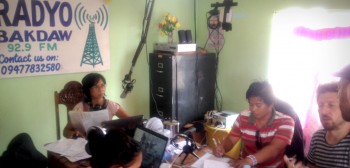Supporting the crucial role of broadcasting in emergency and disaster situations is a key focus for the CBA. We have provided training in disaster reporting and dedicated our 2012 conference to media in disaster and emergency situations. Following on from this, we are keen to share the story of Radyo Bakdaw, a station set up by Internews just over two weeks after Typhoon Haiyan struck the Philippines on 8 November 2013.
Viviane Lucia Fluck, a disaster communications researcher, has arrived in Guiuan to volunteer and document the project. She gave us her first impressions of the scenes of rebuilding one month after the storm:
Arriving at Tacloban airport, it is unmistakably a disaster zone. At the tiny airport, the engines of a large military aeroplane hum as it brings in relief goods – and except for locals flying home, the only other passengers are wearing colourful NGO T-shirts. The UN has set up a makeshift meeting place for NGOs right on the tarmac, and the entrance hall where the crowd waits for their luggage is full of crisis maps and relief info sheets; “Australian citizens: call this number”, “map of NGOs in crisis area”, “want to volunteer?”
The journey from Tacloban to where Yolanda (Haiyan’s local name) hit land, in Guiuan, takes roughly three hours. It leads through an area of vast destruction. The landscape is a juxtaposition of breath-taking coastline on one side and destroyed palm trees – like a pile of toothpicks – on the hills opposite. The majority of the villages on the way are in very bad shape. Signs pleading for help and food are not an uncommon sight.
Although Guiuan is one of the hardest-hit areas, it is plain to see that its citizens have worked hard to recover their lives. There isn’t one building left intact in the city, but the streets are mostly clear and there is no stench of rotting garbage, which persists in some parts of Tacloban.
 Information blackout
Information blackout
Radyo Bakdaw is run by a team of local broadcasters, who are supported by two Internews staff in terms of content and technology. The station is providing useful information for the affected community, a self-produced radio drama, news, a live karaoke contest (a huge hit!) and music. Radios are being distributed and listeners’ questions that come via text messages and letters are being answered.
Around 200 transistor and solar radios have been given out, and the feedback from the local community has been positive. Even if people have to attach long makeshift antennas to the small radios, they are happy that they can listen to information and not be in the dark about what’s happening. There is still no electricity and mobile reception is patchy at best. On top of it all, many lost their phones in the typhoon. “We had total information blackout after Yolanda,” said Rowena, a mother from a small village near Guiuan.
The radio service has received a number of text messages suggesting that there are some cases of corrupt officials. Listeners accuse them of hiding information and hoarding aid. Even though contact is sometime unreliable due to the damaged mobile network, Radyo Bakdaw has recently broken its own record of audience interaction and received 300 texts in just one day. It’s another indicator of how much individuals want their voice to be heard.
Two-way conversation
A big challenge for the station is that its signal can’t reach communities more than 45km away, and Internews is unable to distribute radios to the areas which have been hardest hit – they are only accessible by motorbike or helicopter. Additionally, it is hard to control if radios really stay in the communal areas that they are delivered to.
On the institutional side, one of the hurdles seems to be the international relief system that Radyo Bakdaw operates in. More and more agencies on the ground appreciate the radio station as a great way of communicating with communities. However, headquarters of the same organisations often seem reluctant to prioritise communication in their initial budgeting and planning, especially during the first relief phase.
Even though Radyo Bakdaw is a comparatively small project, it will hopefully help increase two-way communication in disasters, the type of communication that should be firmly on the agenda when relief budgets are discussed far away in Geneva and New York.
Viviane Lucia Fluck is a PhD candidate in Participatory Communication and Disaster Management and Mitigation at the University of East Anglia
Image top: L to R: Lisa, Bill and Stijn at Radyo Bakdaw

 WorldView
WorldView Your WorldView
Your WorldView